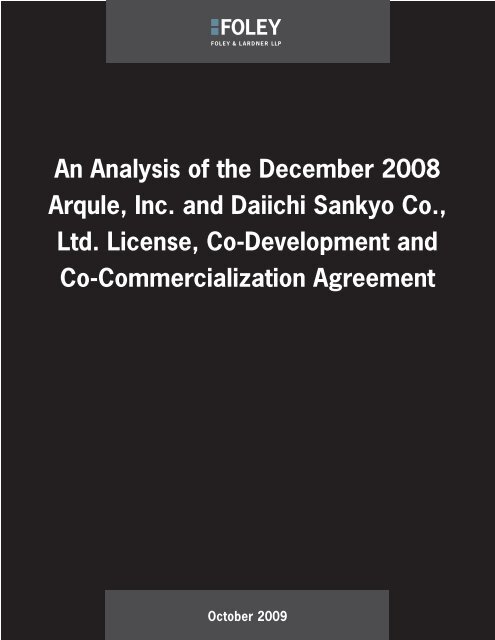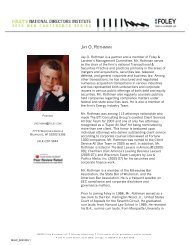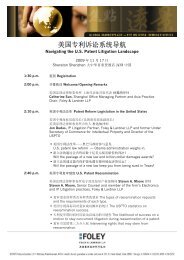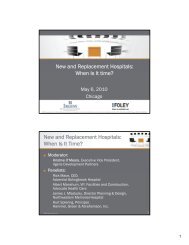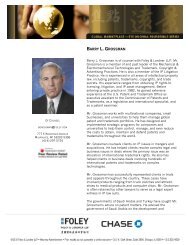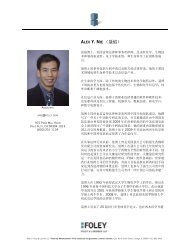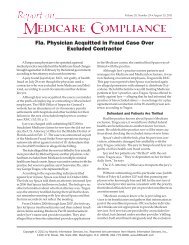Arqule, Inc. and Daiichi Sankyo Co., Ltd. License, Co-Development ...
Arqule, Inc. and Daiichi Sankyo Co., Ltd. License, Co-Development ...
Arqule, Inc. and Daiichi Sankyo Co., Ltd. License, Co-Development ...
Create successful ePaper yourself
Turn your PDF publications into a flip-book with our unique Google optimized e-Paper software.
An Analysis of the December 2008<br />
<strong>Arqule</strong>, <strong>Inc</strong>. <strong>and</strong> <strong>Daiichi</strong> <strong>Sankyo</strong> <strong>Co</strong>.,<br />
<strong>Ltd</strong>. <strong>License</strong>, <strong>Co</strong>-<strong>Development</strong> <strong>and</strong><br />
<strong>Co</strong>-<strong>Co</strong>mmercialization Agreement<br />
October 2009
EXECUTIVE SUMMARY<br />
In this transaction, ArQule <strong>and</strong> <strong>Daiichi</strong> <strong>Sankyo</strong> (DS) agreed to co-develop ARQ 197,<br />
ArQule’s selective c-Met inhibitor, for the treatment <strong>and</strong> prevention human cancer<br />
indications <strong>and</strong> any other indications as agreed by the parties, in the United States,<br />
Europe, South America, <strong>and</strong> the rest of the world, but excluding Japan, China<br />
(including Hong Kong), South Korea, <strong>and</strong> Taiwan because ArQule had previously<br />
granted exclusive rights to Kyowa Hakko Kirin <strong>Co</strong>., <strong>Ltd</strong>. in those countries. ArQule<br />
<strong>and</strong> DS also entered into a separate <strong>Co</strong>llaborative Research, <strong>Development</strong> <strong>and</strong><br />
<strong>License</strong> Agreement dated November 7, 2008 utilizing ArQule’s kinase inhibitory<br />
discovery platform to develop a new generation of highly selective, anti-cancer<br />
kinase inhibitors. In this white paper, we focus on the ARQ 197 <strong>License</strong>, <strong>Co</strong>-<br />
<strong>Development</strong> <strong>and</strong> <strong>Co</strong>-<strong>Co</strong>mmercialization Agreement.<br />
Under the agreement, DS paid ArQule an upfront cash fee of $60 million <strong>and</strong> agreed<br />
to pay up to $560 million in development <strong>and</strong> sales milestones <strong>and</strong> tiered doubledigit<br />
royalties on net sales of ARQ 197 by DS, its affiliates, <strong>and</strong> sublicensees. ArQule<br />
<strong>and</strong> DS are required to equally share the costs of Phase II <strong>and</strong> Phase III clinical<br />
studies, with ArQule’s share of Phase III costs payable solely from milestone <strong>and</strong><br />
royalty payments. DS is required to fund the costs of commercialization, <strong>and</strong> ArQule<br />
has an option to participate in the commercialization of ARQ 197 in the United<br />
States.<br />
The financial terms of the deal were reasonable given the state of the economy in<br />
late 2008 <strong>and</strong> the amount of human efficacy data available at signing. The deal also<br />
increased ArQule’s cash at a time when credit was tight. The deal with DS included<br />
a higher upfront than that of ArQule’s 2007 deal for the Asian rights for ARQ 197<br />
with Kyowa Hakko. The terms of the DS ArQule deal are comparable to other 2008<br />
Phase II cancer deals with disclosed terms. The terms also are comparable (or<br />
higher) than the averages reported by Evaluate Pharma in its trend analysis for<br />
2008 deals. However, in this deal, ArQule has to share in the development costs of<br />
Phase II <strong>and</strong> Phase III, reducing the true value to ArQule.<br />
The overall structure of the transaction was well conceived <strong>and</strong> relatively<br />
straightforward. Sometimes partnering transactions can become overly complicated<br />
<strong>and</strong>, therefore, more susceptible to oversights in structuring <strong>and</strong> drafting the<br />
agreement. In this case, the parties successfully maintained a relatively<br />
straightforward structure <strong>and</strong> drafted a generally fair <strong>and</strong> balanced agreement with<br />
a number of particularly well worded provisions worthy of adaptation by business<br />
development professionals <strong>and</strong> attorneys for use in other deals.<br />
©2009 Foley & Lardner LLP • Attorney Advertisement • Prior results do not guarantee a similar outcome • 321 North Clark Street, Chicago, IL 60654 • 312.832.4500
BACKGROUND<br />
©2009 Foley & Lardner LLP<br />
A Second Japanese Partner for ArQule?<br />
DS, headquartered in Japan <strong>and</strong> ranked 21 st in health care revenues worldwide with<br />
$8 billion in prescription <strong>and</strong> royalty revenues in 2008, was formed by the $15<br />
billion merger of <strong>Daiichi</strong> <strong>and</strong> <strong>Sankyo</strong> in 2005. Sixty-three percent of its sales were in<br />
Japan <strong>and</strong> 21 percent in the United States, with Europe <strong>and</strong> India following. (DS<br />
also owns 63 percent of Ranbaxy Laboratories Limited, the Indian generic firm.)<br />
Cardiovascular products (angiogensin II antagonists , anti-lipid statin) accounted for<br />
51 percent of sales, with oncology products constituting only 0.9 percent of sales<br />
according to Evaluate Pharma.<br />
Recent news includes the July 10, 2009 FDA approval of Effient (prasugrel), an<br />
anti-platelet drug marketed with Eli Lilly & <strong>Co</strong>mpany. In 2007, DS paid Amgen, <strong>Inc</strong>.<br />
$20 million upfront (<strong>and</strong> agreed to pay $150 million in development costs) for<br />
Japanese rights for denosumab, the bone metastasis <strong>and</strong> osteoporosis antibody. In<br />
2008, DS acquired the cancer antibody company, U3 Pharma AG, for $234 million.<br />
In 2009, DS offered to acquire 20 percent of Zenotech Laboratories Limited, already<br />
74-percent owned by Ranbaxy, but the offer has been delayed as minority<br />
shareholders have objected to the price.<br />
ArQule, <strong>Inc</strong>., based in Massachusetts, is a public company with 107 employees <strong>and</strong><br />
a market capitalization of $224 million as of September 23, 2009. ArQule began<br />
with a platform for small molecule lead optimization. ArQule is primarily focused on<br />
oncology, <strong>and</strong> its most advanced products, both in Phase II, are the c-Met inhibitor<br />
ARQ 197 (the subject of this deal) <strong>and</strong> the EF2 inhibitor, ARQ 501, partnered with<br />
Roche. In Phase I are an Alzheimer’s drug c<strong>and</strong>idate with Wyeth <strong>and</strong> an Eg5 kinesin<br />
inhibitor for cancer. In preclinical development are a b-raf program <strong>and</strong> a backup<br />
E2F inhibitor with Roche.<br />
In 2007, <strong>Arqule</strong> granted Kyowa Hakko (now Kyowa Hakko Kirin) rights to ARQ-197<br />
for Japan, South Korea, China, <strong>and</strong> Taiwan in exchange for $30 million in cash <strong>and</strong><br />
up to $93 million in milestones, along with undisclosed sales milestones <strong>and</strong><br />
double-digit royalties.<br />
DS may not have seemed the most obvious partner for the European <strong>and</strong> U.S. rights<br />
to ArQule’s ARQ 197 as ArQule had already partnered with a Japanese company for<br />
Asian rights. Presumably, at the time of negotiations, DS needed to persuade ArQule<br />
of its growing commitment to cancer, where it is currently a relatively minor player.<br />
DS likely touted that much (19/52 projects according to Evaluate Pharma) of its<br />
pipeline is now in oncology. It probably noted its July 2008 deal with Seattle<br />
Genetics, <strong>Inc</strong>. for antibody conjugates, its 2008 acquisition of the cancer antibody<br />
company, U3 Pharma, its 2007 deal with Amgen for denosumab for osteoporosis<br />
2
©2009 Foley & Lardner LLP<br />
<strong>and</strong> for bone metastases in cancer patients, its 2007 deal with Zenotech to market<br />
biosimilar GCSF to treat neutropenia in cancer patients, <strong>and</strong> its 2006 deal for YM<br />
Biosciences’ antibody to EGFR for lung cancer. Also, DS could reasonably persuade<br />
ArQule that ARQ 197 would be a premier <strong>and</strong> advanced product in the DS oncology<br />
pipeline.<br />
Given that the agreement excludes Japan, where DS makes 63 percent of its sales,<br />
it also is interesting to envision the discussions of how DS will maximize the product<br />
in other territories. In Europe, DS is a relatively minor player. Even in the United<br />
States, where DS makes about 21 percent of its sales, DS often is in co-promotion<br />
or joint ventures with large global players. One possibility is that DS will sublicense<br />
the drug for optimal commercialization, although ArQule’s permission is required to<br />
do so for the United States. It is possible that ArQule saw significant value in the<br />
potential for a broader relationship with DS. At the same time as the agreement on<br />
ARQ 197, the two parties announced a research collaboration on allosteric kinase<br />
inhibitors, with DS paying ArQule $15 million upfront <strong>and</strong> paying two years of<br />
research support as well as potential license fees <strong>and</strong> milestones.<br />
Finally, with these deal announcements, ArQule was able to deflect much attention<br />
from the decision by Roche in December 2008 to decline the option on ARQ 761,<br />
the second E2F inhibitor in its 2004 partnership with ArQule.<br />
Overview of Transaction Structure<br />
In this transaction, ArQule <strong>and</strong> DS agreed to co-develop ARQ 197 — as well as any<br />
agreed-upon backup c-Met inhibitor compounds 1 — in the United States, Europe,<br />
South America, <strong>and</strong> the rest of the world, but excluding Japan, China (including<br />
Hong Kong), South Korea, <strong>and</strong> Taiwan. ArQule retained an option to participate in<br />
the commercialization of ARQ 197 in the United States The parties agreed to<br />
collaborate on the clinical development of ARQ 197 as well as commercialization in<br />
the United States if ArQule exercises its co-commercialization option. DS is<br />
responsible for preparing <strong>and</strong> filing drug approval applications, manufacturing <strong>and</strong><br />
supplying ARQ 197 active pharmaceutical ingredient <strong>and</strong> finished drug product, <strong>and</strong><br />
commercialization activities, subject to ArQule’s option to co-commercialize in the<br />
United States An overall joint steering committee will oversee development <strong>and</strong><br />
commercialization of ARQ 197, <strong>and</strong> multiple additional committees that report to<br />
the joint steering committee will oversee specific aspects of the collaboration.<br />
ArQule’s co-commercialization rights in the United States include the rights to codetail<br />
the product, to provide a proportional number of scientific liaisons, to be<br />
1 While the agreement envisions the possibility for back-up c-Met inhibitor compounds, for ease of reference, the<br />
remainder of this white paper uses ARQ 197 to mean both ARQ 197 <strong>and</strong> any c-Met inhibitor back-up compounds agreed<br />
to be developed by the parties under the agreement.<br />
3
©2009 Foley & Lardner LLP<br />
displayed on marketing materials in equal prominence with DS <strong>and</strong> to receive<br />
training from DS prior to commencement of detailing.<br />
Summary of <strong>Co</strong>mmercial Terms<br />
DS paid ArQule an upfront cash fee of $60 million. Potential development <strong>and</strong> salesbased<br />
milestone payments total $560 million. ArQule also will receive tiered doubledigit<br />
royalties on net sales of ARQ 197 by DS, its affiliates, <strong>and</strong> sublicensees. ArQule<br />
<strong>and</strong> DS are required to equally share the costs of Phase II <strong>and</strong> Phase III clinical<br />
studies, with ArQule’s share of Phase III costs payable solely from milestone <strong>and</strong><br />
royalty payments. DS is required to fund the costs of commercialization, <strong>and</strong> ArQule<br />
has an option to co-commercialize ARQ 197 in the United States. ArQule’s milestone<br />
<strong>and</strong> royalty payments will remain the same in the event ArQule exercises its U.S. cocommercialization<br />
option.<br />
ARQ 197, an Inhibitor of a Hot Target, at Phase I at Time of Deal<br />
The target of ARQ 197 is the protein tyrosine kinase c-Met, which has been a target<br />
on the “hot list” for in-licensors. Many human cancers (including cancers of kidney,<br />
liver, stomach, breast, <strong>and</strong> brain) have constitutively increased c-Met activity, either<br />
through over-expression, activating mutations, or increases in the c-Met lig<strong>and</strong>,<br />
hepatocyte growth factor (HGF). Alterations in c-Met signaling have been implicated<br />
in tumor progression, angiogenesis, <strong>and</strong> metastasis.<br />
ARQ 197 inhibits c-Met at an allosteric site not competitive to ATP, unlike most<br />
kinase inhibitors to date. It is likely to have a different profile than ATP competitive<br />
c-Met inhibitors that may share effects at kinases with similar active sites.<br />
ARQ 197 is now in multiple Phase II trials. The first Phase II data has come from a<br />
trial in three relatively rare tumor types (clear cell sarcoma, alveolar soft part<br />
sarcoma, <strong>and</strong> Xp11.2-translocated renal cell carcinoma) sharing the feature of upregulation<br />
of microphthalmia transcription factor (MiT), which is believed to<br />
upregulate c-Met. In these tough-to-treat tumors, out of 28 patients, one patient had<br />
a partial response <strong>and</strong> 17 had stable disease (ASCO 2009). These data were almost<br />
certainly not available at the time of negotiations of the DS ArQule deal.<br />
ARQ-197 also is in Phase II for pancreatic cancer, another tough cancer that<br />
frequently has upregulated c-Met. A Phase I/II non-small-cell lung cancer (NSCLC)<br />
trial has dosing in combination with Tarceva® (erlotinib) because 25 percent of<br />
EGFR failures are attributed to c-Met gene amplification (<strong>Arqule</strong> presentation). In<br />
March 2009, a Phase II trial in hepatocellular carcinoma was initiated.<br />
4
©2009 Foley & Lardner LLP<br />
Significant c-Met Small Molecule <strong>and</strong> Antibody <strong>Co</strong>mpetition (From<br />
PharmaProjects)<br />
c-Met has been seen as an important target for cancer therapeutics with many<br />
tumors having alterations in c-Met signaling.<br />
GlaxoSmithKline (GSK) exercised its option for a c-Met inhibitor GSK-089 (formerly<br />
XL-880) from Exelixis, now in Phase II in papillary renal cell carcinoma. Preliminary<br />
results from 20 evaluable patients included two patients with partial responses<br />
(ASCO 2009).<br />
Bristol-Myers Squibb (BMS) partnered with Exelixis for XL184 (BMS-907351), a<br />
less-selective inhibitor of c-Met, Ret, <strong>and</strong> VEGFR kinases. GSK had previously<br />
declined to exercise its option for this molecule. XL84 is in a Phase III trial in<br />
medullary thyroid cancer patients, with completion expected in 2013; in a Phase<br />
Ib/II trial in NSCLC patients who had disease progression on Tarceva®; <strong>and</strong> in a<br />
Phase II trial in glioblastoma. BMS also has another c-Met inhibitor, BMS-777607,<br />
in a Phase I/II solid tumors trial.<br />
In Phase I are small molecules from Merck, Amgen, Johnson & Johnson, Eisai, <strong>and</strong><br />
Pfizer. MethylGene has a small molecule which hits a number of kinases, including<br />
c-Met in Phase I.<br />
Roche (Genentech) has an antibody to c-Met in a Phase II trial in NSCLC in<br />
combination with Tarceva®. Schering-Plough partnered with AVEO for an antibody<br />
that binds the lig<strong>and</strong>, HGF, now in Phase I.<br />
Analysis<br />
Reasonable Financial Terms. The terms of the DS ArQule deal seem reasonable<br />
given the state of the economy <strong>and</strong> the relatively sparse human efficacy data<br />
available at signing. The deal also increased ArQule’s cash at a time when credit<br />
was tight. The deal with DS had a higher upfront than that of ArQule’s 2007 deal for<br />
the Asian rights for ARQ 197 with Kyowa Hakko. Kyowa Hakko paid $30 million<br />
upfront <strong>and</strong> a total of $123 million for the opportunity in Phase I. The terms of the<br />
DS ArQule deal are comparable to other 2008 Phase II cancer deals with disclosed<br />
terms. The terms also are comparable (or higher) than the averages ($36 million<br />
upfront <strong>and</strong> total of $193 million) reported by Evaluate Pharma in its trend analysis<br />
for 2008 deals. However, in this deal, ArQule has to share in the Phase II <strong>and</strong> Phase<br />
III development costs, reducing the true value to ArQule.<br />
5
Licensor <strong>License</strong>e Date Product Stage at<br />
Signing<br />
ArQule <strong>Daiichi</strong> Dec.<br />
<strong>Sankyo</strong> 2008<br />
Exelixis BMS Dec.<br />
2008<br />
Avant Pfizer April<br />
2008<br />
Amgen Takeda Feb<br />
2008<br />
Genentech<br />
(now<br />
Roche)<br />
Biogen<br />
Idec<br />
©2009 Foley & Lardner LLP<br />
Oct.<br />
2008<br />
ARQ 197<br />
(c-Met)<br />
XL184<br />
(c-Met)<br />
<strong>and</strong><br />
XL281<br />
(b-raft)<br />
CDX-<br />
110,<br />
EGFRvIII<br />
vaccine<br />
AMG<br />
706<br />
(KDR)<br />
GA101,<br />
Ab to<br />
CD20<br />
Up<br />
Front<br />
Mile-<br />
stones<br />
Phase II $60MM Up to<br />
$560MM<br />
Phase III, $195 Up to<br />
Phase I MM $150MM<br />
Phase II $40MM Up to<br />
$390MM<br />
Phase II $100<br />
MM<br />
Phase I/II $31.5<br />
MM<br />
Up to<br />
$175MM<br />
Profit<br />
share<br />
Equity<br />
Investment<br />
Royalties<br />
DoubledigitDoubledigit<br />
$10MM Doubledigit <br />
Doubledigit<br />
DS was able to materially de-risk its investment in ARQ 197 by requiring ArQule to<br />
directly <strong>and</strong> equally share Phase II development costs <strong>and</strong> equally share in Phase III<br />
development costs out of milestone <strong>and</strong> royalty payments previously paid or payable<br />
in the future by DS. The deal is not structured as a profit-split to account for<br />
ArQule’s obligation to share in development costs, so presumably ArQule was able<br />
to negotiate for higher royalties than it otherwise would have received had DS been<br />
responsible for all development costs.<br />
DS is required to pay all commercialization costs, including ArQule’s fully burdened<br />
commercialization costs in the event ArQule exercises its U.S. co-commercialization<br />
right, provided that ArQule’s costs do not exceed DS’ fully burdened costs of<br />
employing or otherwise engaging its own representatives who detail DS’ oncology<br />
products in the United States. In addition, the agreement permits a proportional<br />
reduction of the ArQule costs to be paid by DS to the extent ArQule’s sales force<br />
also details other products not covered by the collaboration.<br />
ArQule’s royalty share does not increase in the event it elects to co-commercialize<br />
ARQ 197 in the United States. Presumably, ArQule negotiated for the U.S. cocommercialization<br />
right because either it can leverage the sales force from its copromotion<br />
with Roche for the E2F inhibitor ARQ 501, or build a sales force at DS’<br />
expense <strong>and</strong> under DS’ tutelage, without needing to insist on requiring a higher<br />
revenue share from DS. Any co-commercialization by ArQule, however, will likely<br />
require additional indirect costs, particularly additional legal compliance costs. It is<br />
unclear from the agreement whether those additional indirect costs will be payable<br />
by DS.<br />
6
©2009 Foley & Lardner LLP<br />
Analysis of Agreement Terms<br />
<strong>Co</strong>mmittee Decisions. The parties carefully considered how to resolve disputes in<br />
the event the parties cannot unanimously agree at the committee level:<br />
DS has the final decision with respect to certain undisclosed matters<br />
ArQule has the final decision with respect to certain other undisclosed<br />
matters<br />
The parties will resort to arbitration with respect to some additional<br />
matters<br />
For certain decisions requiring unanimity, the parties have to find a way<br />
to agree without being permitted to resort to arbitration<br />
Resorting to formal third-party arbitrators to decide matters of drug development or<br />
commercialization strategy may be problematic, but presumably the parties<br />
carefully identified those key strategic decisions as requiring unanimous approval or<br />
being within the final decision-making power of one party.<br />
<strong>Co</strong>mmercial Supply. Under the agreement, DS has sole responsibility for<br />
manufacture <strong>and</strong> supply of ARQ 197 active pharmaceutical ingredient <strong>and</strong> finished<br />
drug product. ArQule successfully negotiated for the right to require DS to<br />
manufacture <strong>and</strong> supply ARQ 197 API <strong>and</strong> finished drug product for ArQule’s thirdparty<br />
licensees <strong>and</strong> collaborators outside of DS’ licensed territory pursuant to terms<br />
of a supply agreement to be negotiated by the parties in good faith. This<br />
requirement gives ArQule <strong>and</strong> Kyowa Hakko Kirin another potential source of supply<br />
for Kyowa’s Asian territory.<br />
Diligence. DS is obligated under the agreement to use commercially reasonable<br />
efforts to develop <strong>and</strong> commercialize ARQ 197 for all Targeted Indications in the<br />
Field <strong>and</strong> in the Territory. The agreement includes a useful definition of<br />
commercially reasonable efforts requiring the comparable efforts <strong>and</strong> resources as<br />
DS would use for similar-staged products with similar market potential. However, it<br />
is somewhat unclear what the parties meant by requiring commercially reasonable<br />
efforts for “all Targeted Indications in the Field <strong>and</strong> in the Territory.” Targeted<br />
Indications are defined as all cancer indications as well as any other non-cancer<br />
indications the parties subsequently agree to include under the agreement. Given<br />
some other provisions in the agreement regarding “New Cancer Indications” (see<br />
Right to <strong>Co</strong>nduct Additional Clinical Trials, below), the parties probably meant that<br />
DS has to use commercially reasonable efforts to develop <strong>and</strong> commercialize ARQ<br />
197 in those indications that the applicable committee decides to include in the<br />
global development plan. However, a strict reading of this provision would require<br />
DS to pursue all cancer indications. In addition, it is not clear whether DS’<br />
obligations would be satisfied if it pursues development <strong>and</strong> commercialization in<br />
only part of the territory, or even only one country in the territory. This question<br />
7
©2009 Foley & Lardner LLP<br />
could become important given DS’ relatively small commercial presence in Europe.<br />
In some agreements, licensors specify that the licensee is required to use<br />
commercially reasonable efforts to purse regulatory approval for, <strong>and</strong> commercialize<br />
in, certain major market countries within the territory, so that a licensee is not<br />
obligated to pursue every country, but is obligated to pursue at least the major<br />
markets.<br />
Data-Sharing With Other <strong>Co</strong>llaborators. Sharing data generated by one collaborator<br />
with a licensor’s other collaborators is a common issue in partnering transactions.<br />
The DS-ArQule agreement includes a useful structure to address this issue by<br />
providing that ArQule may share clinical information <strong>and</strong> regulatory filings generated<br />
by DS with any other licensees <strong>and</strong> collaborators, provided other licensees <strong>and</strong><br />
collaborators have granted ArQule the reciprocal right to share clinical information<br />
<strong>and</strong> regulatory filings with DS. With respect to safety information, the agreement<br />
provides that at ArQule’s request, DS <strong>and</strong> ArQule will meet with Kyowa to discuss<br />
information <strong>and</strong> coordination with respect to adverse event reporting <strong>and</strong> other<br />
safety matters.<br />
Reimbursement of ArQule’s <strong>Co</strong>-<strong>Co</strong>mmercialization <strong>Co</strong>sts. As mentioned above, in<br />
the event ArQule exercises its right to co-commercialize ARQ 197 in the United<br />
States, DS is required to reimburse ArQule for its fully burdened cost incurred in<br />
conducting co-commercialization activities. The costs to be reimbursed may be no<br />
more than the fully burdened cost to DS of engaging its own representatives who<br />
detail DS’ oncology products in the United States. Smaller companies often need to<br />
pay higher compensation to sales representatives <strong>and</strong> others in its commercial<br />
structure in order to attract top talent from Big Pharma. Therefore, this provision<br />
adds a measure of control over the co-commercialization costs DS will need to pay.<br />
The downside for DS is that in order to exercise its right to limit costs under this<br />
provision, it may need to disclose sensitive financial information regarding its own<br />
cost structure with respect to commercialization of other oncology products.<br />
Right to <strong>Co</strong>nduct Additional Clinical Trials. From time-to-time, one party in a<br />
collaboration may desire to conduct studies that are not approved by the other<br />
party, particularly with oncology products where there are a number of different<br />
tumor types that may be explored. This agreement contains a noteworthy provision<br />
allowing either party to conduct a clinical trial in a cancer indication that is not part<br />
of the jointly approved global development plan, at such party’s sole expense.<br />
The additional study may not be performed if the joint steering committee or<br />
designated senior officers of the parties determine that there is a substantial safety<br />
risk in the proposed clinical trial that is greater than the safety risk in other clinical<br />
trials of the same product being conducted by the parties for other cancer<br />
indications, or that there is a material risk of adversely affecting the label of the<br />
product for other cancer indications as a result of the proposed clinical trial. The<br />
agreement provides that this determination be made as a “joint decision,” meaning<br />
8
©2009 Foley & Lardner LLP<br />
that if there is disagreement, the determination goes to arbitration under the<br />
dispute resolution mechanism. It is not entirely clear whether the party desiring to<br />
conduct an additional clinical trial would need to wait until conclusion of the<br />
arbitration proceeding if there is a disagreement as to safety or potential label<br />
impact. The agreement further provides for protocol review <strong>and</strong> comment by the<br />
other party <strong>and</strong> reimbursement of a portion of costs if the product receives<br />
regulatory approval in the United States, a major European country, or the EU for<br />
the additional indication. The right to conduct an additional clinical trial may only<br />
be exercised once every two years by each party.<br />
Each <strong>License</strong>d Product. The development <strong>and</strong> regulatory milestones <strong>and</strong> sales<br />
milestones are payable for each licensed product, as opposed to payable one time<br />
regardless of how many licensed products achieve the milestones. The royalty tiers<br />
are similarly based on sales levels obtained for each product. When milestones are<br />
payable for each product or sales milestone tiers are separate for each product, it is<br />
often helpful to clarify when two products are to be considered the same product or<br />
different products. For example, the parties may want to clarify whether different<br />
dosage strengths, formulations, or therapeutic indications are considered the same<br />
product or different products. It is not clear whether the agreement includes this<br />
type of clarifying provision in the redacted text.<br />
Generic <strong>Co</strong>mpetition. Parties frequently negotiate for a reduced royalty rate in the<br />
event a product faces generic competition above a certain threshold in a particular<br />
jurisdiction. This agreement contains a well written generic competition provision,<br />
appropriately determining the threshold level of competition based on unit sales.<br />
The provision also includes a noteworthy feature in that once sales of the generic<br />
product reach a baseline level, a specific royalty rate reduction applies, <strong>and</strong> then if<br />
sales of the generic product reach a higher percentage of overall unit sales, a<br />
different, presumably larger, royalty rate reduction applies. The specific threshold<br />
sales levels <strong>and</strong> percentage royalty reductions were not disclosed in the redacted<br />
agreement.<br />
<strong>License</strong> to ArQule Outside of the Territory. DS agreed to grant to ArQule a nonexclusive<br />
license to DS’s intellectual property for use by ArQule in manufacturing,<br />
developing <strong>and</strong> commercializing ARQ 197 outside of DS’s territory. Similar to the<br />
data sharing provision, ArQule is permitted to grant sublicenses under its license to<br />
DS intellectual property to third-party licensees <strong>and</strong> collaborators only if the other<br />
licensee or collaborator granted ArQule the reciprocal right to include its intellectual<br />
property in the license grant to DS.<br />
Right to Sublicense in the United States. DS is not permitted to sublicense U.S.<br />
commercialization rights in the United States without ArQule’s prior written consent.<br />
This ability to ensure DS is the commercializing party in the United States is<br />
particularly important for ArQule given its co-commercialization right.<br />
9
©2009 Foley & Lardner LLP<br />
ArQule’s Rights Upon Termination. The agreement contains thorough provisions for<br />
ArQule’s rights upon termination. In the event of termination, other than by DS for<br />
breach by, or insolvency of, ArQule, DS has the following obligations, among others:<br />
Assign to ArQule, free of charge, all product trademarks<br />
Assign or grant to ArQule an exclusive, worldwide, royalty-free license to<br />
all DS intellectual property rights specific to ARQ 197 <strong>and</strong> a nonexclusive,<br />
worldwide, royalty-free license under all other DS intellectual<br />
property necessary or useful to manufacture, develop <strong>and</strong> commercialize<br />
ARQ 197<br />
Transfer all regulatory filings to ArQule <strong>and</strong> provide all regulatory<br />
correspondence to ArQule<br />
Assign to ArQule all agreements for the manufacture of ARQ 197 or the<br />
conduct of clinical trials for ARQ 197, <strong>and</strong> cooperate with ArQule to<br />
obtain the consent to assignment for any agreements where assignment<br />
is prohibited<br />
Provide all inventory of ARQ 197 to ArQule<br />
If DS is the manufacturer, supply ArQule its requirements of ARQ 197 for<br />
a specific, but undisclosed, period of time at a price equal to DS’s<br />
manufacturing cost for the first portion of that period, <strong>and</strong> at a cost-plus<br />
price for the rest of the period<br />
In the event DS terminates the agreement for breach by, or insolvency of, ArQule,<br />
DS retains its license rights <strong>and</strong> payment obligations, but ArQule is required to pay<br />
for the license rights it receives under the agreement from DS in an amount to be<br />
negotiated in good faith by the parties.<br />
10
©2009 Foley & Lardner LLP<br />
About the Authors<br />
David A. Charapp<br />
Mr. Charapp is Special <strong>Co</strong>unsel with Foley & Lardner LLP. He represents life<br />
sciences companies in structuring, drafting, <strong>and</strong> negotiating a wide variety<br />
of transactions, including strategic collaborations, licenses, co-promotion<br />
agreements, manufacturing <strong>and</strong> supply agreements, distribution<br />
agreements, pre-clinical <strong>and</strong> clinical research agreements, agreements with<br />
managed care organizations <strong>and</strong> government payors, wholesaler<br />
agreements, public <strong>and</strong> private financing transactions, mergers,<br />
acquisitions <strong>and</strong> dispositions. He can be reached at dcharapp@foley.com or<br />
619.685.4606.<br />
Richard A. Kaufman<br />
Mr. Kaufman is a Partner with Foley & Lardner LLP. He has significant<br />
experience with a wide variety of corporate <strong>and</strong> securities transactions for<br />
companies in the life sciences industry, including developers of drugs,<br />
biologics, medical devices, <strong>and</strong> discovery <strong>and</strong> informatics tools. His practice<br />
includes structuring <strong>and</strong> negotiation of strategic partnerships <strong>and</strong><br />
collaborations, technology transfers <strong>and</strong> licenses, spin-out transactions,<br />
manufacturing agreements, <strong>and</strong> clinical research agreements as well as<br />
engagements for public offerings, private placements, mergers,<br />
acquisitions, <strong>and</strong> divestitures. He can be reached at rkaufman@foley.com or<br />
619.685.4614.<br />
Linda Pullan, Ph.D.<br />
Dr. Pullan is a business development consultant<br />
(www.pullanconsulting.com) with more than 20 years of licensing <strong>and</strong> drug<br />
discovery experience at Kosan Biosciences, Amgen, <strong>and</strong> AstraZeneca. She is<br />
the author of “Pullan's Pieces,” a free e-mail newsletter on science <strong>and</strong><br />
business topics. To subscribe, send your request to lpullan@msn.com.<br />
11


